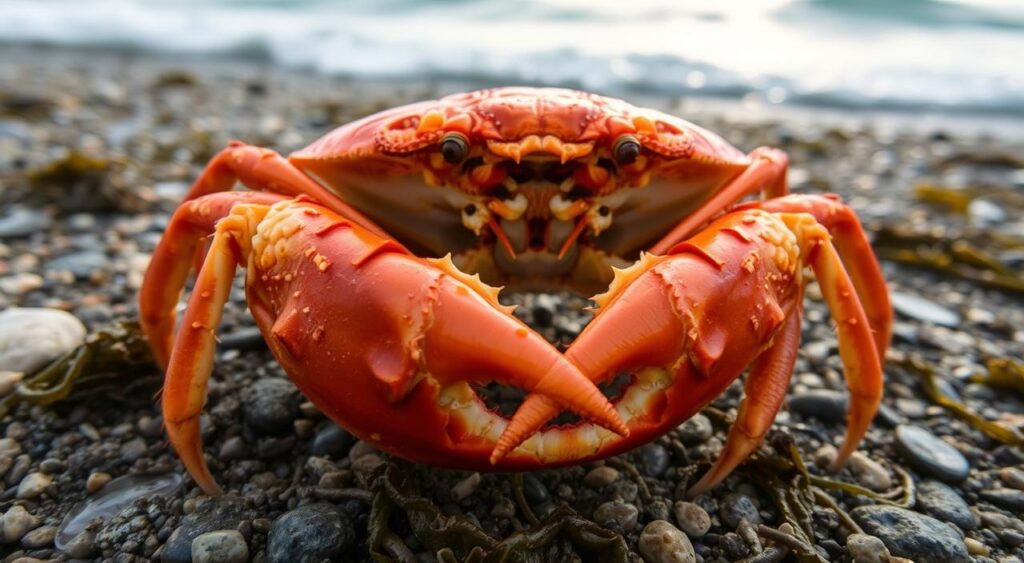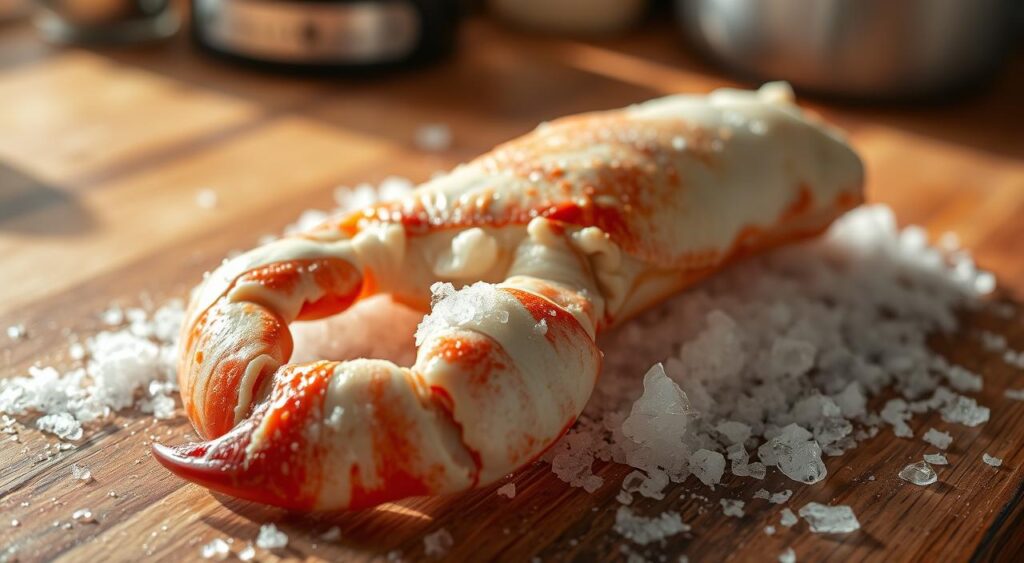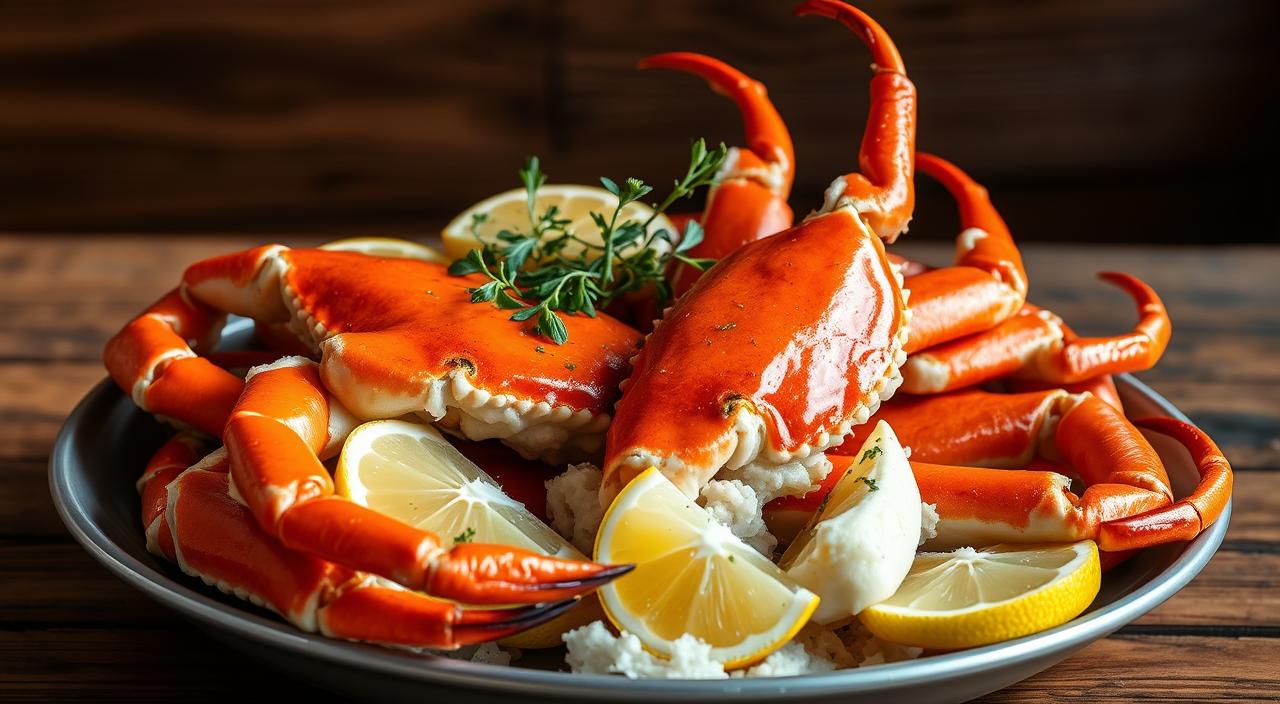Imagine biting into the sweet, tender meat of a freshly cooked Alaskan king crab. This seafood is a true treasure, found in the cold waters of the North Pacific. Whether you’re a pro chef or a home cook, learning to cook king crab can make any meal special.
In this guide, we’ll explore the world of king crab. We’ll look at its types, where to find it, and how to prepare it. You’ll learn about boiling, steaming, grilling, and baking. These tips will help you make your king crab dishes unforgettable. Get ready to enjoy the flavors and impress your loved ones with your cooking skills.
Understanding King Crab Varieties

There are three main types of Alaskan king crab: Red King Crab, Blue King Crab, and Golden King Crab. Each has its own taste and size, making them perfect for different dishes.
Red King Crab vs Blue King Crab
The Red King Crab, or Paralithodes camtschaticus, is famous for its rich flavor and big size. It’s mainly caught in the Bering Sea areas of Bristol Bay and Norton Sound. On the other hand, Blue King Crab has huge claws and a milder taste.
Golden King Crab Characteristics
The Golden King Crab is smaller but has a sweet flavor and a golden color. It’s found in the Bering Sea and is easier to find than the other two types.
Seasonal Availability and Sourcing
The seasons for these king crab types are different. Red King Crab is available from October to January. Dungeness crab is caught from May to December. Fishing rules help keep these crabs safe in the Bering Sea.
Essential Preparation Steps

Getting ready to cook king crab is key to making it perfect. First, thaw frozen crab legs in the fridge or under cold water. After thawing, rinse them and dry with paper towels.
For boiling or steaming, you might want to cut off some shell. This lets the crab meat soak up flavors better and makes it easier to eat.
Cleaning and prepping the king crab is easy but important. Rinse the thawed legs under cool water to remove dirt. Then, dry them well with paper towels.
If you’re cooking in the shell, you can skip the shell removal. But, removing some shell can make the crab look better and be easier to eat.
Remember, the secret to great king crab is not to overcook it. Be careful with cooking times and temperatures, no matter the method. With the right thawing, cleaning, and prepping steps, you’re set for a tasty king crab feast.
Selecting and Purchasing Quality King Crab
Choosing the right king crab is key to enjoying its delicious taste. Look for wild-caught Alaskan king crab for its top-notch quality and eco-friendliness. The size of the crab matters too, as bigger ones have more meat.
Size and Grade Guidelines
Alaskan Red King Crab prices vary from $50 to $80 per pound. Golden King Crab is cheaper, priced between $35 to $50 per pound. King crab leg pieces are around $25 to $40 per pound, a more affordable choice.
Fresh vs Frozen Options
Fresh king crab should be shiny, firm, and smell slightly salty. Stay away from crab with color changes or a strong fish smell. For frozen crab, check for vacuum-sealed packages without ice crystals. This shows it was frozen quickly to keep its quality.
Sustainability Considerations
Choosing sustainable king crab is important. Go for crab from regulated fisheries like Alaska. This supports crab fishing and sustainable seafood practices. It also ensures you get seafood quality you can trust.
Thawing Methods and Best Practices
Proper thawing is key to enjoying king crab. The best way is to thaw it in the fridge overnight. This keeps the crab meat juicy and tender, without losing flavor.
For faster thawing, put the crab leg package in cold water. It takes 1-2 hours. Make sure to change the water every 30 minutes to keep it cold. Avoid hot water or the microwave, as they can ruin the crab’s texture and flavor.
After thawing, use the crab legs within 24-48 hours for the best taste. This ensures you enjoy the king crab’s succulent flavor at its peak.
“Properly thawing king crab is the foundation for achieving perfect results in the kitchen.”
Thawing king crab right is a simple but crucial step. It lets you enjoy the crab’s sweet, tender meat. By following these tips, you can make amazing crab dishes.
Basic Equipment and Tools Needed
Preparing and enjoying king crab is better with the right tools. You’ll need kitchen tools and serving equipment. Let’s look at the essential items for a great king crab experience.
Essential Kitchen Equipment
You’ll need a large pot for boiling or steaming king crab legs and claws. Baking sheets are great for oven cooking. And, a pair of kitchen shears or scissors makes removing shells easy.
Recommended Serving Tools
Tongs are key for handling hot crab legs safely. They make transferring from pot to plate easy. For eating, offer crab crackers, picks, and small forks to get every bit of meat.
Adding melted butter warmers and lemon wedge holders will make your presentation better. With the right tools and seafood utensils, your king crab feast will wow your guests.
Traditional Boiling Method
Cooking it by boiling is quick and simple. This method lets you add tasty flavors to the crab legs. It also makes sure they’re cooked just right.
Start by filling a big pot with salted water. Bring it to a boil. Then, add your king crab legs to the boiling water. Let them cook for 5-7 minutes, until they’re hot all the way through.
The boiling method is great because you can add your favorite flavors. Try adding herbs, lemon wedges, or Old Bay seasoning. These will make the crab taste amazing.
“Boiling is a quick and easy way to enjoy the sweet, tender meat of king crab legs. The method allows you to infuse the crab with your favorite seasonings for a truly delectable seafood feast.”
Whether you’re having a big seafood boil or just want a special meal, boiling is a good choice. It’s easy and brings out the crab’s natural flavors. This method is sure to be a favorite in your kitchen.
Steaming Techniques for Perfect Results
Steaming is a moist and flavorful way to cook them. It keeps the crab’s natural moisture and flavor. Start by getting a large pot ready with a steamer basket or colander insert for the crab legs.
Proper Steaming Times
For thawed there legs, steam for 6-10 minutes, depending on size. Frozen legs need 12-15 minutes to heat through. Remember, overcooking makes crab tough and rubbery, so watch the time closely.
Seasoning During Steaming
To boost the steamed crab‘s flavor, add simple ingredients to the steaming liquid. Salt, garlic, lemon wedges, or fresh herbs are great. For more flavor, try Old Bay or other seafood spices.
Mastering moist cooking methods like steaming brings out king crab’s sweet meat. With the right prep and tricks, you’ll impress everyone with your seafood feast.
Grilling and Baking Alternatives
Grilled king crab legs offer a smoky taste and charred edges. Preheat your grill to medium-high heat. Then, brush the grilled seafood lightly with oil or melted butter. Grill the crab legs for 4 to 6 minutes, turning occasionally, until they’re heated through and the meat is tender. The natural sweetness of the crab pairs beautifully with the subtle char from the grill.
Oven-baked crab legs are another great option. Preheat your oven to 350°F. Place the crab legs on a baking sheet with a small amount of water or melted butter. Cover the tray loosely with foil and bake for 12 to 15 minutes, until the crab is heated through and the meat is tender and flavorful.
“Grilling or baking king crab legs is a great way to enjoy this delicacy at home, without the hassle of boiling or steaming. The high heat method adds a unique smoky element that complements the natural sweetness of the crab.”
Make sure to thaw the crab legs thoroughly before cooking. This ensures even heating and optimal texture. With a few simple steps, you can elevate your king crab experience. Enjoy the perfect balance of sweet, tender meat and smoky, caramelized flavor.
Flavoring and Seasoning Options
King crab offers endless flavor options. Classic seasonings like dill, rosemary, and Old Bay are great. They bring out the crab’s natural sweetness. For something new, try ginger-soy dipping sauce or garlic-herb butter.
Using top-notch herbs and spices can make your king crab dishes stand out. Fresh parsley, tarragon, and cilantro add freshness. Auntie Nonos Everything Seasoning adds a savory touch that pairs well with seafood. The quality of your seasonings greatly affects the taste of your king crab.
Classic Butter Sauces
No king crab feast is complete without a rich, melted butter for dipping. Add fragrant herbs like basil or mint for elegance. For a bolder taste, try Cajun seasoning or lemon-garlic butter.
Contemporary Flavor Combinations
Try new dipping sauces and marinades for your king crab. A sweet and spicy honey-chili glaze or a tangy ginger-soy sauce can take your crab to new levels. Experiment to find the perfect flavor for you.
“The key to unlocking the full potential of king crab is in the seasoning. Embrace a variety of herbs, spices, and sauces to create a truly memorable dining experience.”
Serving Suggestions and Presentation Tips
Make your crab feast stand out with great seafood plating and presentation. Start by placing the king crab legs on a big, eye-catching platter. Add fresh herbs like dill, parsley, or chives, and colorful lemon wedges for a pop of color. Give your guests crab cracking devices and seafood forks to enjoy the crab meat easily.
Pair the king crab with sides that match its rich taste. Roasted potatoes, a crisp salad, or grilled asparagus are great choices. For wine, choose a dry white like Pinot Grigio or Chardonnay, or a light red like Pinot Noir. These will bring out the crab’s sweetness.
For a wow factor, try a seafood tower with the crab legs layered. This not only looks amazing but also makes it easy for guests to try different crab types. Top the tower with fresh herbs, lemon wedges, and colorful veggies for a crab feast that will be remembered.
“The secret to a successful crab feast is in the presentation. Elevate the experience with thoughtful seafood plating and the right accompaniments.”
Conclusion
Learning to cook king crab elevates your culinary skills, allowing you to shine with seafood dishes at home. Understanding the different types and how to source them is essential.
Additionally, mastering how to thaw, prepare, and cook it properly is important. This way, you can create a feast that’s both impressive and delicious, enjoying the sweet, tender meat this seafood is known for.
When cooking, whether boiling, steaming, grilling, or baking, handle it gently. Experiment with various sauces and seasonings to enhance the flavor. By following the tips in this article, you’ll become a pro at preparing king crab and impress your loved ones with your new skills.
The king crab industry is thriving, and you can take pride in being part of it. Enjoy the process of sourcing, preparing, and serving this unique seafood. Let your culinary skills flourish with expertise in seafood preparation.
FAQ
What are the main types of Alaskan king crab?
Alaskan king crab comes in three types: red, blue, and golden. Red king crab from Bristol Bay and Norton Sound is the most sought-after. It has a rich, buttery flavor. Blue king crab, also known as red crab, has large claws and a milder, sweeter taste. Golden king crab is the smallest but still widely available, with a mild, sweet flavor.
How do I properly thaw frozen king crab legs?
To thaw king crab legs well, place them in the fridge overnight. For faster thawing, put them in a sealed bag and soak in cold water. Avoid using hot water or a microwave, as it can ruin the crab’s texture and taste.
What essential equipment is needed to cook them?
You’ll need a big pot for boiling or steaming, baking sheets for oven cooking, and kitchen shears for removing shells. Tongs are handy for handling hot crab legs. For serving, have crab crackers, picks, and small forks ready to help get the meat out.
What are some common cooking methods?
It can be cooked by boiling, steaming, grilling, or baking. Boiling is quick and simple. Steaming keeps the crab moist and flavorful. Grilling adds a smoky taste, and baking is a straightforward oven method.
How do I season and flavor king crab?
Classic flavors include melted butter, lemon wedges, and seafood seasoning. Try flavored butters like garlic-herb or Cajun-spiced for a twist. For something new, use hot honey butter or Asian-style ginger-soy dipping sauce. Add wine, citrus, or herbs to cooking liquids for extra flavor.
